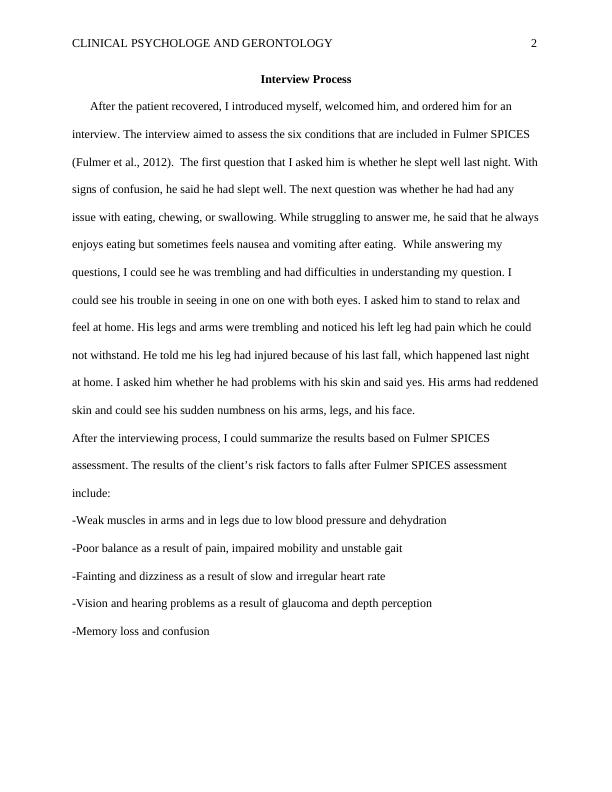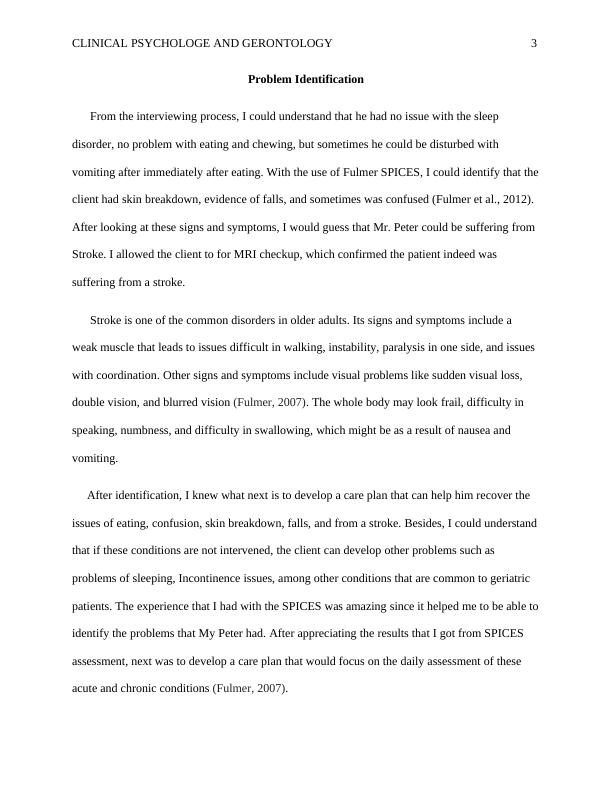Clinical Psychology and Gerontology
Added on 2023-03-30
7 Pages1622 Words229 Views
Running head: CLINICAL PSYCHOLOGE AND GERONTOLOGY 1
Clinical Psychology and Gerontology
Introduction
Unintentional falls among the aged remains of the challenging safety issues facing
healthcare specialists around the world. It is the most common cause of accidental death and
injury (Fulmer, Greenberg & Wallace, 2012). To lower the risk of injury and accident from falls,
interviewing strategies that make the use of SPICES tool can be used to identify the risks and
provide a further evaluation. Fulmer SPICES remains as one of the crucial frameworks that are
used to assess older adults. It focuses on 6 common conditions referred to as “marker
conditions.” These marker conditions include Sleep diseases, Problems with eating and feeding,
Incontinence, confusion, evidence of falls, and skin breakdown. These marker conditions provide
the image of the overall health conditions of the aged and provide the guidelines on health care
services that they need (Fulmer et al., 2012). The assessment can be done regularly to prevent
and treat these common markers.
This paper involves my assessment process with a client Mr. Peter. Peter is 82 years old
married to Irene. He presented to the emergency department in Monash Medical center, where I
work as a gerontology nurse. The client looked old and weak, and one could tell he was in a poor
state of his health. The nurse took him to the gerontology department, where I provide
assessment for older clients who visit the hospital while in the poor state of their health.
. He had a complicated medical history, including frequent falls and Stroke.
Clinical Psychology and Gerontology
Introduction
Unintentional falls among the aged remains of the challenging safety issues facing
healthcare specialists around the world. It is the most common cause of accidental death and
injury (Fulmer, Greenberg & Wallace, 2012). To lower the risk of injury and accident from falls,
interviewing strategies that make the use of SPICES tool can be used to identify the risks and
provide a further evaluation. Fulmer SPICES remains as one of the crucial frameworks that are
used to assess older adults. It focuses on 6 common conditions referred to as “marker
conditions.” These marker conditions include Sleep diseases, Problems with eating and feeding,
Incontinence, confusion, evidence of falls, and skin breakdown. These marker conditions provide
the image of the overall health conditions of the aged and provide the guidelines on health care
services that they need (Fulmer et al., 2012). The assessment can be done regularly to prevent
and treat these common markers.
This paper involves my assessment process with a client Mr. Peter. Peter is 82 years old
married to Irene. He presented to the emergency department in Monash Medical center, where I
work as a gerontology nurse. The client looked old and weak, and one could tell he was in a poor
state of his health. The nurse took him to the gerontology department, where I provide
assessment for older clients who visit the hospital while in the poor state of their health.
. He had a complicated medical history, including frequent falls and Stroke.

CLINICAL PSYCHOLOGE AND GERONTOLOGY 2
Interview Process
After the patient recovered, I introduced myself, welcomed him, and ordered him for an
interview. The interview aimed to assess the six conditions that are included in Fulmer SPICES
(Fulmer et al., 2012). The first question that I asked him is whether he slept well last night. With
signs of confusion, he said he had slept well. The next question was whether he had had any
issue with eating, chewing, or swallowing. While struggling to answer me, he said that he always
enjoys eating but sometimes feels nausea and vomiting after eating. While answering my
questions, I could see he was trembling and had difficulties in understanding my question. I
could see his trouble in seeing in one on one with both eyes. I asked him to stand to relax and
feel at home. His legs and arms were trembling and noticed his left leg had pain which he could
not withstand. He told me his leg had injured because of his last fall, which happened last night
at home. I asked him whether he had problems with his skin and said yes. His arms had reddened
skin and could see his sudden numbness on his arms, legs, and his face.
After the interviewing process, I could summarize the results based on Fulmer SPICES
assessment. The results of the client’s risk factors to falls after Fulmer SPICES assessment
include:
-Weak muscles in arms and in legs due to low blood pressure and dehydration
-Poor balance as a result of pain, impaired mobility and unstable gait
-Fainting and dizziness as a result of slow and irregular heart rate
-Vision and hearing problems as a result of glaucoma and depth perception
-Memory loss and confusion
Interview Process
After the patient recovered, I introduced myself, welcomed him, and ordered him for an
interview. The interview aimed to assess the six conditions that are included in Fulmer SPICES
(Fulmer et al., 2012). The first question that I asked him is whether he slept well last night. With
signs of confusion, he said he had slept well. The next question was whether he had had any
issue with eating, chewing, or swallowing. While struggling to answer me, he said that he always
enjoys eating but sometimes feels nausea and vomiting after eating. While answering my
questions, I could see he was trembling and had difficulties in understanding my question. I
could see his trouble in seeing in one on one with both eyes. I asked him to stand to relax and
feel at home. His legs and arms were trembling and noticed his left leg had pain which he could
not withstand. He told me his leg had injured because of his last fall, which happened last night
at home. I asked him whether he had problems with his skin and said yes. His arms had reddened
skin and could see his sudden numbness on his arms, legs, and his face.
After the interviewing process, I could summarize the results based on Fulmer SPICES
assessment. The results of the client’s risk factors to falls after Fulmer SPICES assessment
include:
-Weak muscles in arms and in legs due to low blood pressure and dehydration
-Poor balance as a result of pain, impaired mobility and unstable gait
-Fainting and dizziness as a result of slow and irregular heart rate
-Vision and hearing problems as a result of glaucoma and depth perception
-Memory loss and confusion

CLINICAL PSYCHOLOGE AND GERONTOLOGY 3
Problem Identification
From the interviewing process, I could understand that he had no issue with the sleep
disorder, no problem with eating and chewing, but sometimes he could be disturbed with
vomiting after immediately after eating. With the use of Fulmer SPICES, I could identify that the
client had skin breakdown, evidence of falls, and sometimes was confused (Fulmer et al., 2012).
After looking at these signs and symptoms, I would guess that Mr. Peter could be suffering from
Stroke. I allowed the client to for MRI checkup, which confirmed the patient indeed was
suffering from a stroke.
Stroke is one of the common disorders in older adults. Its signs and symptoms include a
weak muscle that leads to issues difficult in walking, instability, paralysis in one side, and issues
with coordination. Other signs and symptoms include visual problems like sudden visual loss,
double vision, and blurred vision (Fulmer, 2007). The whole body may look frail, difficulty in
speaking, numbness, and difficulty in swallowing, which might be as a result of nausea and
vomiting.
After identification, I knew what next is to develop a care plan that can help him recover the
issues of eating, confusion, skin breakdown, falls, and from a stroke. Besides, I could understand
that if these conditions are not intervened, the client can develop other problems such as
problems of sleeping, Incontinence issues, among other conditions that are common to geriatric
patients. The experience that I had with the SPICES was amazing since it helped me to be able to
identify the problems that My Peter had. After appreciating the results that I got from SPICES
assessment, next was to develop a care plan that would focus on the daily assessment of these
acute and chronic conditions (Fulmer, 2007).
Problem Identification
From the interviewing process, I could understand that he had no issue with the sleep
disorder, no problem with eating and chewing, but sometimes he could be disturbed with
vomiting after immediately after eating. With the use of Fulmer SPICES, I could identify that the
client had skin breakdown, evidence of falls, and sometimes was confused (Fulmer et al., 2012).
After looking at these signs and symptoms, I would guess that Mr. Peter could be suffering from
Stroke. I allowed the client to for MRI checkup, which confirmed the patient indeed was
suffering from a stroke.
Stroke is one of the common disorders in older adults. Its signs and symptoms include a
weak muscle that leads to issues difficult in walking, instability, paralysis in one side, and issues
with coordination. Other signs and symptoms include visual problems like sudden visual loss,
double vision, and blurred vision (Fulmer, 2007). The whole body may look frail, difficulty in
speaking, numbness, and difficulty in swallowing, which might be as a result of nausea and
vomiting.
After identification, I knew what next is to develop a care plan that can help him recover the
issues of eating, confusion, skin breakdown, falls, and from a stroke. Besides, I could understand
that if these conditions are not intervened, the client can develop other problems such as
problems of sleeping, Incontinence issues, among other conditions that are common to geriatric
patients. The experience that I had with the SPICES was amazing since it helped me to be able to
identify the problems that My Peter had. After appreciating the results that I got from SPICES
assessment, next was to develop a care plan that would focus on the daily assessment of these
acute and chronic conditions (Fulmer, 2007).

End of preview
Want to access all the pages? Upload your documents or become a member.
Related Documents
Mental Health Nursing Paper Case Study Of Major Depressionlg...
|10
|2283
|1060
Case Study on Emerging Management Techniques - Mr. Jasonlg...
|11
|4054
|72
ESSAY l REGISTERED NURSE IN A HOSPITALlg...
|7
|1913
|26
